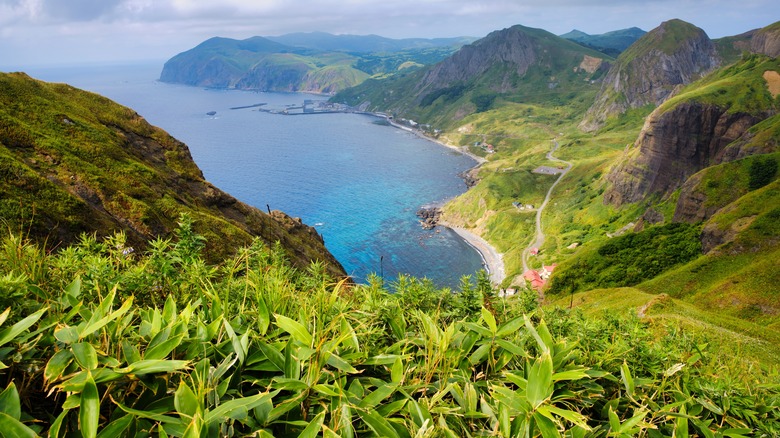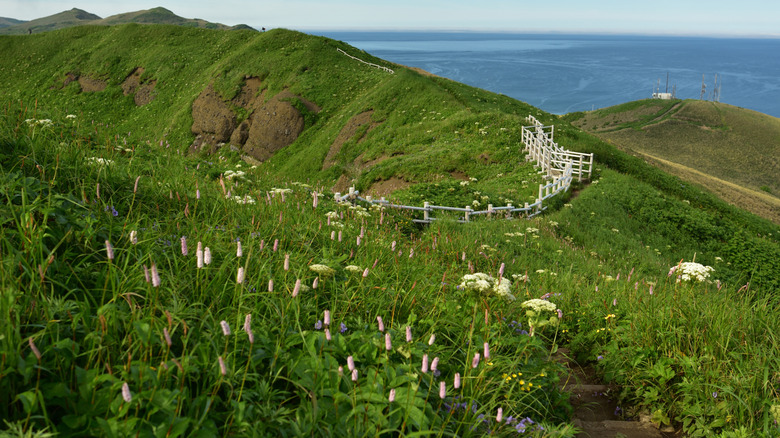Japan's 'Floating Island Of Flowers' Boasts Magnificent Views Of Stunning Coastal Alps
Many travelers visit Japan for its wealth of nature, from the most spectacular cherry blossom views to fall foliage views in Shizuoka. But off the northern tip of Hokkaido, Rebun Island sits like a "floating island of flowers" in the Sea of Japan. This remote gem is covered with around 300 alpine species — many of which are rare and unique to the island. While winters are unforgiving, spring and summertime from June to August is when the island blooms to life, drawing nature lovers from all over.
Rebun's cool temperatures explain why flowers normally found thousands of feet above sea level do so well here. Imagine walking along cliff-edged trails where colorful blossoms stand out against the blue ocean backdrop. Hikes like the famous Momoiwa ("Peach Rock") Observatory Course treat visitors to sweeping views of rugged mountain landscape, fields of wildflowers, and neighboring Mount Rishiri rising in the distance.
Visitors to Rebun shouldn't miss out on the island's gourmet seafood specialties, either. Robata Chidori is an island staple near the port that's been serving gourmet sea urchin and mackerel dishes since the 1940s. With Rebun's rolling green hills protected under national park status and quaint fishing villages, it's a place where nature feels curated yet wild.
Key hiking trails and highlights of Rebun Island
The seven trails on Rebun Island are well-kept and easy to follow. The three-hour Momoiwa Course is one of the most popular, and you can actually walk to the trailhead from the ferry port. Hikers following this moderate trail can take in sweeping views from the Momoiwa observatory and the Motochi lighthouse on the southern end of the island. Longer routes include the Eight-hour Course and the Cape Tour Course starting at the northern tip of the island. But many courses can be done in sections, and there's even the easy Lake Kushu Course that circles a lake in under two hours.
Hikers will pass through fields of Rebun's native edelweiss (Leontopodium discolor) — tiny, star-shaped blossoms that sparkle in the coastal breeze. The northern part of the island features large collections of lady slipper orchids, Asian skunk cabbage, and much more. With trail signs marking the way and caretakers maintaining the paths, it's easy to lose yourself in nature without getting lost.
You can easily explore Rebun Island on your own — just pick up an English-language trail map at the ferry terminal. However, visitors wanting a more in-depth experience can look into guided hikes. There are group and private options for hire, and these tours can lead you to secret spots you might miss otherwise, as well as educate you about the plant species across the island.
Practical tips for visiting Rebun's coastal alps
To get to the island, start by flying or taking a train to Wakkanai, Hokkaido's northern hub, then hop on the ferry, to reach Rebun in just under two hours. There's also a shorter ferry from neighboring Rishiri Island — another beautiful stop you can pair with Rebun — which has a domestic airport for flights from the main island. The island is walkable and bike-friendly — you can rent bikes or take a sightseeing bus to reach major attractions. You can bring a car if you're road tripping around Hokkaido, however car rentals are also available on the island (and bringing your car on the ferry can be pricey at around $200).
For a true off-the-grid experience, consider staying in a local inn along the coast, which will give you a chance to meet the locals (believe it or not, a few thousand people actually live on the island) and enjoy fresh seafood. Visitors should bring good hiking boots, layered clothing (coastal breezes can be chilly), and, of course, a camera. Keep in mind that some of the trails are quite long, so a daypack with water and snacks is a good idea. Buses run to different trailheads, but check the schedule ahead of time to avoid long waits between departures.
While Hokkaido is a great winter destination for skiing and snowboarding, nature lovers may want to plan a spring/summer trip just to visit Rebun and Rishiri islands. Rebun is a special crossover of alpine and ocean landscapes with rare blooms you likely won't see anywhere else in the world. It's not a stop on most Japan itineraries, but for those who venture here, it leaves an imprint far deeper than any postcard.


